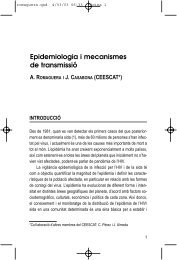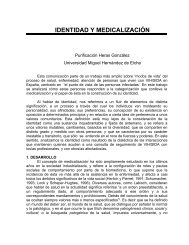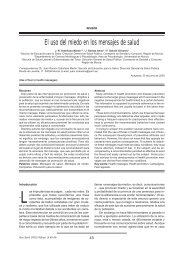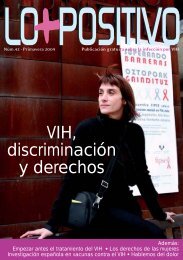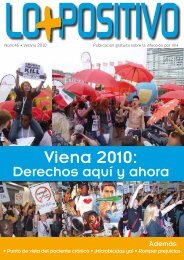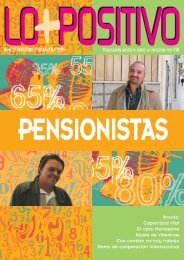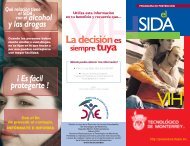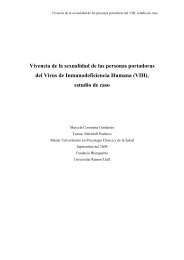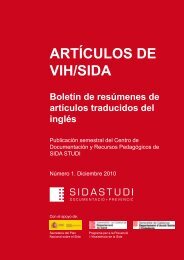Report - Sida Studi
Report - Sida Studi
Report - Sida Studi
Create successful ePaper yourself
Turn your PDF publications into a flip-book with our unique Google optimized e-Paper software.
Thursday 29 September 2005<br />
4: Opening session<br />
dialogue between young people and religious leaders. See<br />
appendix 4 for some extracts from the video presentation.<br />
4.3 Oral presentations<br />
4.31 Epidemiology, Migrants and HIV/AIDS, Dr Julia Del<br />
Amo, Universidad Miguel Hernández de Elche<br />
Dr Julia Del Amo gave the meeting an overview of the<br />
epidemiological data relating to HIV/AIDS and migrancy.<br />
She highlighted progress in reporting and recording of<br />
infections as well as some remaining problems with these<br />
data.<br />
Dr Del Amo began by describing the important role<br />
played by health surveillance data in the development of<br />
public health activity. She noted the greater visibility of<br />
data relating to HIV/AIDS and migrancy in recent years<br />
and the clear evidence that this put into the public arena<br />
about the vulnerability of migrant people. She described<br />
some of the issues associated with bringing data of this<br />
kind into the public arena, noting that while it had the<br />
potential benefit of focusing public health activity on<br />
groups with particular needs and vulnerabilities it also<br />
generated the potential for stigmatisation of migrant people.<br />
She noted the need, in particular, to work with the<br />
media. These have a powerful influence on public perceptions<br />
of the links between migrancy and public health in<br />
the context of wider concerns about immigration, work<br />
and social welfare provision.<br />
Presenting longitudinal data from Western, Central and<br />
Eastern Europe, Dr Del Amo demonstrated the explosive<br />
spread of injecting drug use-related HIV in Eastern<br />
Europe and noted how easily this might have been prevented<br />
by interventions. Looking at AIDS surveillance,<br />
she demonstrated the trends towards decreasing AIDS<br />
cases in Western Europe with the wider availability of<br />
antiretroviral treatment.<br />
Looking specifically at data on the origin of new HIV<br />
infections, she illustrated the rise in heterosexual infections<br />
acquired abroad, mainly in sub-Saharan Africa, and<br />
the evidence that the burden of new infections is largely<br />
borne by younger people. While she warned that there<br />
are some problems with achieving total consistency when<br />
it comes to extracting exactly comparable data on HIV<br />
among migrant young people, Dr Del Amo pointed out<br />
that in their current state data suggest that differentials in<br />
rates of infection with HIV and conversion to AIDS are<br />
associated with access to treatment and care.<br />
She noted that one effect of exploring epidemiological<br />
data in relation to ethnicity and migrancy seemed<br />
to be to show that highly active antiretroviral therapy<br />
(HAART) is making inequality in HIV care more visible<br />
in countries with free access to treatment and care.<br />
Dr Del Amo concluded with a call for action to achieving<br />
the following:<br />
• Development of scientifically valid and culturally appropriate<br />
definitions of ethnicity and migrancy;<br />
• Empowerment of communities to interpret and use data<br />
relating to HIV/AIDS and migrancy, and hence to influence<br />
the direction of funding;<br />
• Working with the media to avoid stigmatisation.<br />
4.32 Pre-meeting report, Mr Julian Hows,<br />
Global Network of PLWHA<br />
Mr Julian Hows presented some headlines from the<br />
pre-meeting for people living with HIV/AIDS (PLWHA).<br />
He noted that PLWHA should be allowed to be visible<br />
in society in order to be able to shoulder responsibilities<br />
for their health and the health of others. Achieving<br />
this visibility is entirely dependent on a commitment to<br />
meet their basic human rights to feel safe and socially<br />
included. Without this they have no position from which<br />
to embrace responsibilities for themselves and others.<br />
Mr Hows went on to note that there had been many<br />
meetings which had produced many words and little<br />
action. Meantime that situation for migrant PLWHA was<br />
deteriorating, with tighter rules of immigration emerging<br />
across Europe and more barriers to access to treatment<br />
and care. He stressed that what was needed was commitment<br />
to adopting a rights-based approach so that rather<br />
than pleading for support, treatment and care on the<br />
basis of vulnerability, PLWHA demanded what was theirs<br />
by right.<br />
Mr Hows noted that migrant PLWHA were doubly disadvantaged<br />
because all too often refugee organisations,<br />
including organisations arising from their own communities,<br />
tend to focus on their needs as refugees rather than<br />
identifying them as PLWHA, and HIV organisations tend<br />
to focus on their needs as PLWHA rather than as refugees<br />
and migrants.<br />
He concluded by asking for the following four things<br />
from the meeting:<br />
• Real partnership to create enabling environments that<br />
make a real difference;<br />
• That participants consider if they are one of these partner<br />
organisations;<br />
• That it accept the contribution of the pre-meeting into<br />
its workshops and other sessions;<br />
• That people accept the opportunity to form a virtual<br />
HIV and migrancy network.<br />
The presentation closed with a dramatic and emotional<br />
climax when, at the invitation of Mr Hows, several people<br />
began the process of challenging stigmatisation and<br />
exclusion by identifying themselves as PLWHA.<br />
11



